|
|
Any student of predictions will tell you they are almost always wrong, especially the ones about the future. Most predictions about AI will be too.
Thanks to our prehistoric brains, humanity has a demonstrated capacity to ignore the 99 out of 100 predictions that are wrong and to focus instead on that one guy out of 100 who accidentally got it right.
Everybody remembers how Michael Burry successfully predicted the Global Financial Crisis and profited from it, as shown in the movie The Big Short.
Nobody remembers he gave similar predictions of impending financial doom in 2015, 2017, 2019, 2021, 2022 and 2023.
Research also shows that the more confident and emphatic someone is about their prediction, the more likely they are to be wrong. So it’s worth being extremely skeptical of anyone predicting massive layoffs and population collapse from AI, or some future utopia where everyone is somehow rich after being “freed” from the drudgery of work by the robots.
What invariably happens is a bunch of developments that nobody really considered, but which seem obvious in hindsight.
With that in mind, here’s the future of work and AI according to “experts.” If you want to skip the doom and gloom stuff you can skip ahead to PWC’s positive research into our AI jobs future by clicking here.
Global population collapse from the AI Job-ocalypse
Tabloid newspapers, including The Sun and the New York Post, ran breathless claims this week from an “Oklahoma tech expert” predicting that job losses caused by AI will cause a global population collapse from 8 billion to 100 million by the year 2300.
Subhash Kak, who teaches computer science at Oklahoma State University, claimed the impact of AI on employment was “going to be devastating for society and world society.”
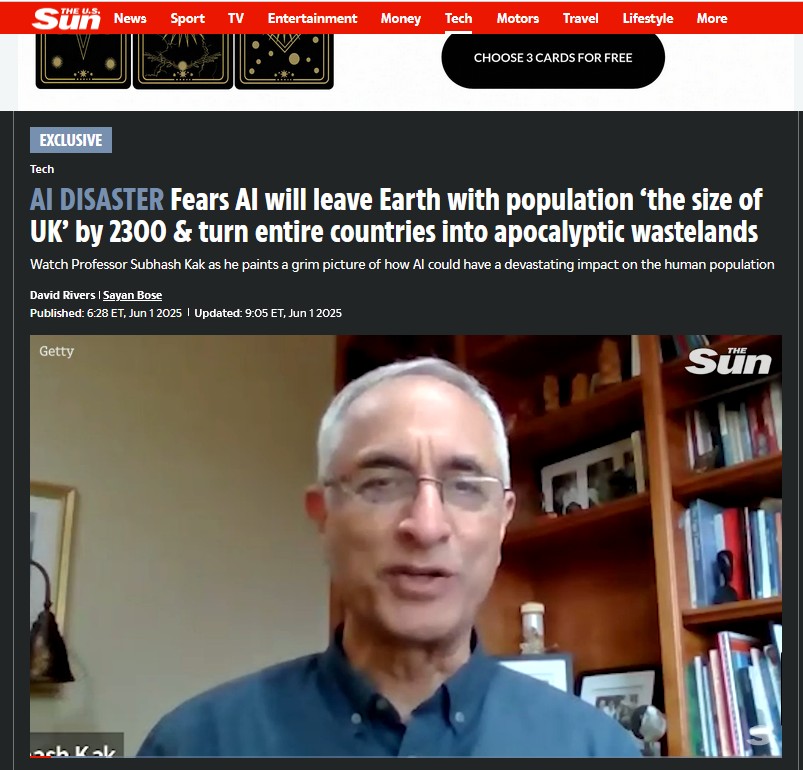
His argument is that birth rates will plummet after AI and robots take all the jobs because no one will be able to afford to have kids — especially kids who will be unemployed and never leave home.
“There are demographers who are suggesting that as a consequence, the world population will collapse, and it could go down to as low as just 100 million people on the entire planet Earth in 2300 or 2380,” he said.
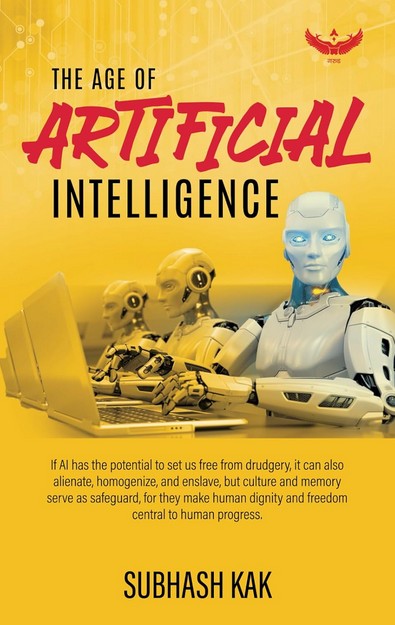
“I have all the data in the book. This is not just my personal opinion,” he said. Actually, it’s not just his personal opinion; it’s also a shameless plug for his book Age of Artificial Intelligence.
Kak, who received his engineering degree in 1970, does have some runs on the AI board relating to neural networks and training algorithms, but he has advanced highly questionable theories before about uncovering the laws of science through Yogic meditation and enlightenment.
AI job losses are a big concern
While predictions of global population collapse sound far-fetched, a lot of very smart people are very concerned about job losses connected to AI, including your AI Eye columnist, who just took out a large mortgage.
Figures as diverse as Barack Obama and Steve Bannon have raised the issue, particularly in light of Anthropic CEO Dario Amodei’s recent prediction that AI could wipe out half of entry level white collar jobs within five years and see unemployment spike to 10-20%.
“Most of them are unaware that this is about to happen,” Amodei told Axios. “It sounds crazy, and people just don’t believe it.”
On the upside, he said AI might also cure cancer and balance the US budget. So I guess the future unemployed people might just have to take one for the team.
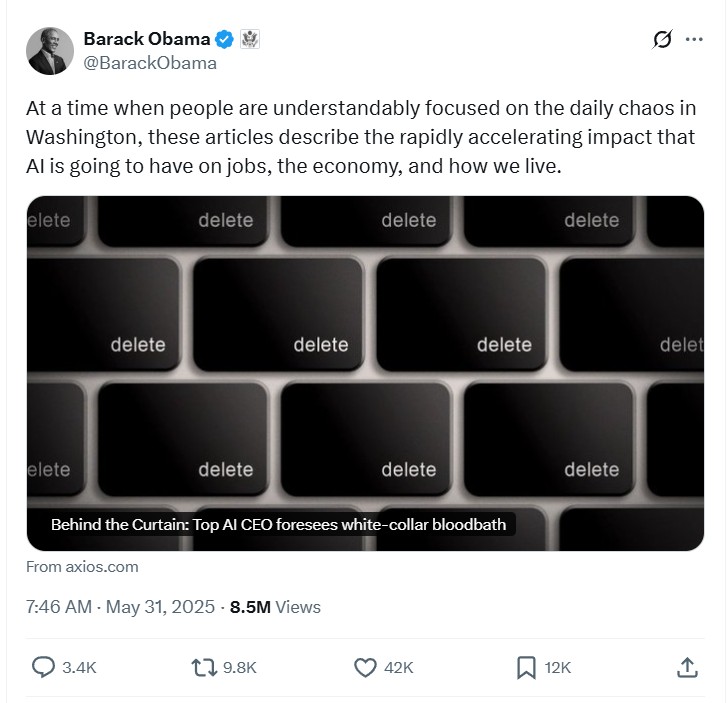
There are already some worrying signs. Unemployment for recent US college graduates has jumped to an unusually high 5.8%, and those most affected are concentrated in fields like finance and computer science, where AI has already been widely deployed.
“There are signs that entry-level positions are being displaced by artificial intelligence at higher rates,” Oxford Economics wrote in a recent report.
Signalfire also reports that new hire software engineers with less than a year of experience fell by 24% in 2024.
Workers benefit from using AI in their jobs too
A survey of US workers by Pew Charitable Trusts found that 42.3% are now using generative AI at work. They report using it for about a third of tasks, resulting in a tripling of productivity (that is, they could do something that normally took 90 minutes, in about half an hour).
A separate survey at the end of last year found that companies report they are only seeing small to moderate gains so far from AI use, and no major impact on wages or hours worked. But as the PWC report below found, that seems to be changing quickly.
Also read: AI cures blindness, ‘good’ propaganda bots, OpenAI doomsday bunker
PWC finds AI jobs future already bringing higher wages
A PWC analysis of 1 billion job ads and thousands of company financial reports has found that AI makes many workers more valuable to companies rather than less, by helping them work more productively and efficiently.
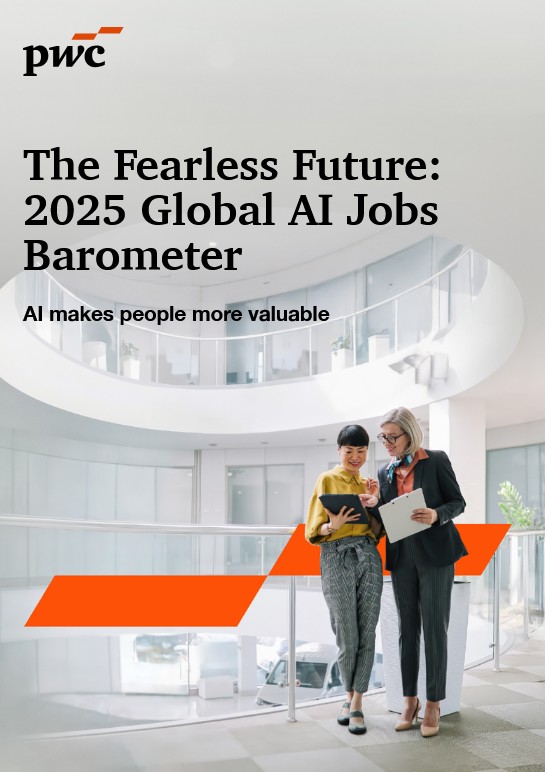
The report suggests that industries most able to take advantage of AI see a 3x higher growth in revenue generated per employee. Wages in those industries are growing twice as fast as the industries least exposed to AI. The conclusion is that as the workers are able to create more value using AI, their wages go up.
Productivity growth in these AI-powered industries has nearly quadrupled, and workers with in-demand AI skills like prompt engineering are getting paid a 56% premium.
The benefits reportedly held true even for jobs that are highly automatable, like customer service agents. While automation can displace workers, the report authors state it can also “change the nature of people’s jobs, freeing them from automatable tasks so they can focus on other (often higher value) tasks. Our data suggests that, on the whole, automation is having the latter effect.”
But employees will need to move with the times, as the skills sought by employers in AI-exposed industries are changing 66% faster than in non-exposed industries.
“Contrary to fears about job losses, job numbers — and wages — are growing in virtually every AI-exposed occupation, including the most highly automatable jobs,” PWC concludes.
The authors do concede that code monkeys and data entry clerks may disappear in their current form in the future, but offer the glass half full perspective that with declining working age populations in many western countries, fewer jobs but higher pay might work out anyway.
“Could AI help to bring about a ‘Goldilocks’ era of job growth that is just right for the size of the working age population — and avert ‘a looming economic crisis as older populations expand and the pool of workers shrinks’?”
The report sounds like it was written by acolytes of Marc Andreessen’s Techno Optimist Manifesto, so let’s hope the rosy picture of the future they paint comes true, as it’s definitely preferable to the population collapse Mad Max scenario.
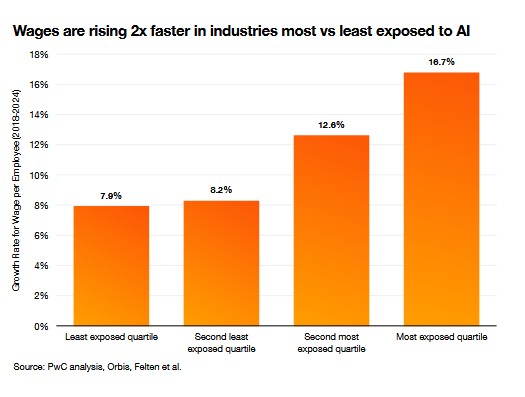
Which industries are most exposed to AI?
Healthcare is the industry being disrupted the fastest by AI, according to a new study by Yijin Hardware that examined investments in AI startups, the top uses for AI tech in the industry, and related Google searches.
Around $4.2 billion has been invested in healthcare AI startups using the technology for things like analyzing X-rays and MRIs or to develop drugs.
Finance was second with $2.1 billion, using AI for things like fraud monitoring and trade automation.
Marketing and advertising were third, followed by legal services, then education and learning.
Construction is the least affected by AI — at least until the robots get better — insurance was the second least affected, then real estate, manufacturing and agriculture.
Market researchers under threat from fake AI human societies
One of the difficulties with predicting the future impact of AI on employment is that some use cases are straight out of left field. A new wave of startups is reportedly trying to disrupt the $140 billion market research industry by testing products on simulated human societies populated by AI agents, according to a new report from a16z.
Traditional market research recruits panels of people and asks them what they think about stuff. But this new approach was inspired by the landmark paper “Generative Agents: Interactive Simulacra of Human Behavior,” where a small simulated town of 25 agents was left to get on with building their own fake society.
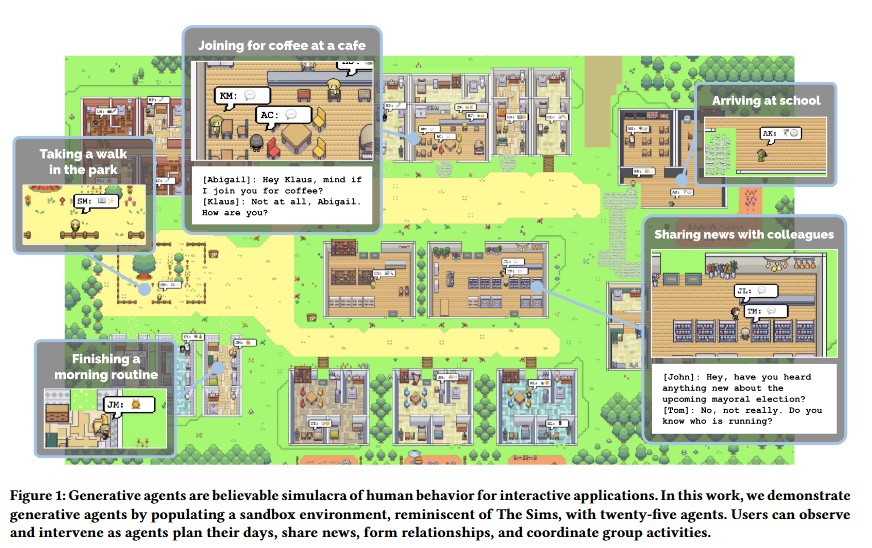
The report gave the example of a skincare launch. A beauty company could create 10,000 agents based on the huge troves of data advertisers have built up on their Gen Z and millennial consumers. Those agents can interact with each other, view simulated influencer content, shop, and post fake reviews in AI-simulated social feeds while being experimented on by the researchers, changing the parameters.
While the data produced may not be as accurate, a16z says marketing bosses would be happy with 70% of the accuracy of traditional market research, given the cost savings and ability to update in real time.
The AI agents “can be queried, observed, and experimented with, modeling real human behavior. This turns market research from a lagging, one-time input into a continuous, dynamic advantage,” the report said.
The potential for advertisers to become even better at manipulating consumers by experimenting on the agents is pretty clear, though a16z doesn’t raise it.
LUMA AI kills VFX industry… but could reinvigorate movies
Luma AI’s Modify Video feature just dropped, and the footage produced so far suggests the days of VFX studios paying 100 full-time staff for six months to create a 1-minute CGI sequence are coming to an end.
Film anyone doing anything, and the system can drop in a new background and visual effect. The processed footage retains the human elements, motion and camera dynamics, while seamlessly adding in expensive-looking effects, a spaceship scene, a car chase, animation or new costumes — all without motion capture, greenscreen or complex 3D software.
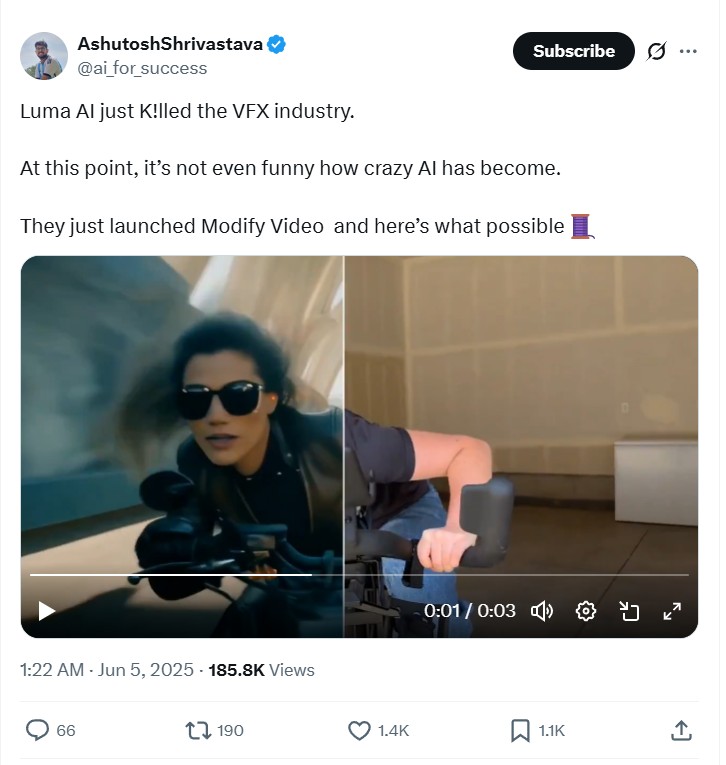
One positive aspect is that it retains the human actors while reducing the costs of production, which could open up movie-making to a lot more people. Good ideas, creative scripts and charismatic actors may become more important than enormous VFX budgets.
Given how uninspired and formulaic Hollywood movies have become since the model moved to ludicrously expensive VFX-driven tentpole movies, we might end up with a wave of creative and original movies from as yet unknown talents limited only by their imaginations.
Introducing Modify Video. Reimagine any video. Shoot it in post with director-grade control over style, character, and setting. Restyle expressive performances, swap entire worlds, or redesign the frame to your vision. Shoot once. Shape infinitely. pic.twitter.com/9yH7fu5WFV
— Luma AI (@LumaLabsAI) June 4, 2025
All Killer, No Filler AI News
— ChatGPT has hit 1 billion searches per day, with Indian users the largest share of traffic at 13.5%, compared to US users at 8.9%. Paid subscribers grew 153% in a year, suggesting it might make money one day.
— Peer-reviewed research in Joule estimates that AI will account for 49% of global data center usage by the end of the year — surpassing even Bitcoin mining’s energy use.
— Over four months next year, Chicago restaurant Next will serve a nine-course menu with each course dreamed up by an AI trained on famous chefs, including sushi master Jiro Ono and haute cuisine expert Auguste Escoffier… who died in 1935.
— Sci-fi author David Brin told Magazine last year that we will need to get AIs to police other AIs, as that’s the only way humans will be able to keep up with their superior capabilities. One of the godfathers of AI, Yoshua Bengio, is trying to do just that, with his $30 million Scientist AI project to detect rogue systems trying to deceive humans.
— Samsung is reportedly nearing a deal with Perplexity to preload its app and assistant on the Galaxy S26 series next year. There are rumors that Apple may do likewise.
— A $1.5 billion AI company called Builder.AI that claimed to use AI to let users build apps turned out to be a fraud, in which “AI” stood for 700 “Anonymous Indians” who actually did the work. The company has filed for bankruptcy.
— According to Australian government research, one in 10 kids has experienced sexual extortion, with 40 percent of those extorted with AI-created nude deepfakes.
— Microsoft has made its Sora video generator free using the Bing apps for iOS and Android.


Andrew Fenton
Good luck suing crypto exchanges, market makers over the flash crash
